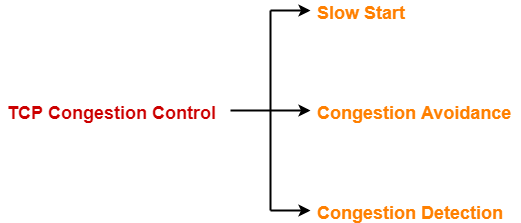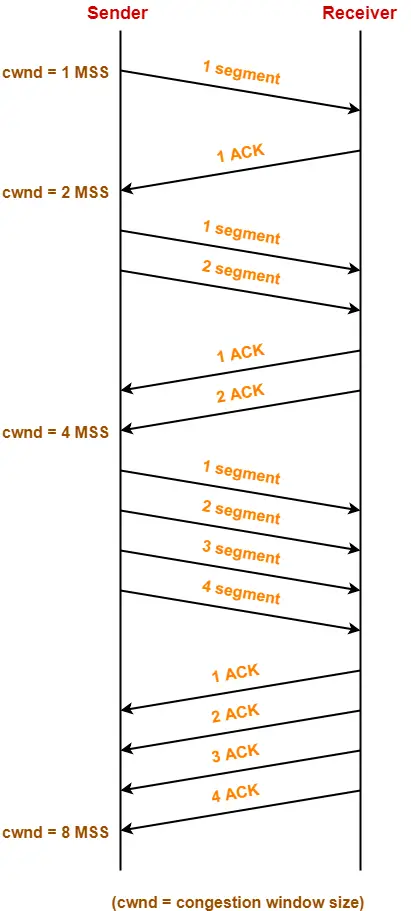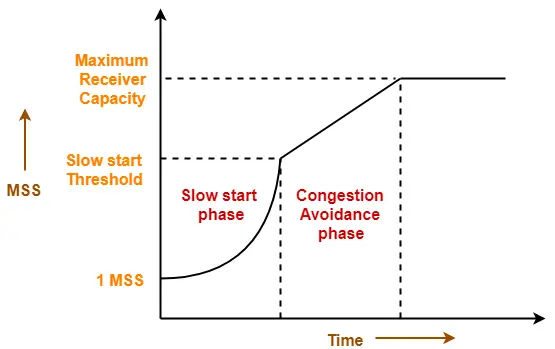Congestion in Network-
| Congestion refers to a network state where-
The message traffic becomes so heavy that it slows down the network response time. |
- Congestion is an important issue that can arise in Packet Switched Network.
- Congestion leads to the loss of packets in transit.
- So, it is necessary to control the congestion in network.
- It is not possible to completely avoid the congestion.
Congestion Control-
Congestion control refers to techniques and mechanisms that can-
- Either prevent congestion before it happens
- Or remove congestion after it has happened
Now, let us discuss how congestion is handled at TCP.
TCP Congestion Control-
| TCP reacts to congestion by reducing the sender window size. |
The size of the sender window is determined by the following two factors-
- Receiver window size
- Congestion window size
1. Receiver Window Size-
| Receiver window size is an advertisement of-
“How much data (in bytes) the receiver can receive without acknowledgement?” |
- Sender should not send data greater than receiver window size.
- Otherwise, it leads to dropping the TCP segments which causes TCP Retransmission.
- So, sender should always send data less than or equal to receiver window size.
- Receiver dictates its window size to the sender through TCP Header.
2. Congestion Window-
- Sender should not send data greater than congestion window size.
- Otherwise, it leads to dropping the TCP segments which causes TCP Retransmission.
- So, sender should always send data less than or equal to congestion window size.
- Different variants of TCP use different approaches to calculate the size of congestion window.
- Congestion window is known only to the sender and is not sent over the links.
So, always-
| Sender window size = Minimum (Receiver window size, Congestion window size) |
TCP Congestion Policy-
TCP’s general policy for handling congestion consists of following three phases-

- Slow Start
- Congestion Avoidance
- Congestion Detection
1. Slow Start Phase-
- Initially, sender sets congestion window size = Maximum Segment Size (1 MSS).
- After receiving each acknowledgment, sender increases the congestion window size by 1 MSS.
- In this phase, the size of congestion window increases exponentially.
The followed formula is-
| Congestion window size = Congestion window size + Maximum segment size |
This is shown below-

- After 1 round trip time, congestion window size = (2)1 = 2 MSS
- After 2 round trip time, congestion window size = (2)2 = 4 MSS
- After 3 round trip time, congestion window size = (2)3 = 8 MSS and so on.
| This phase continues until the congestion window size reaches the slow start threshold.
Threshold = Maximum number of TCP segments that receiver window can accommodate / 2 = (Receiver window size / Maximum Segment Size) / 2 |
2. Congestion Avoidance Phase-
After reaching the threshold,
- Sender increases the congestion window size linearly to avoid the congestion.
- On receiving each acknowledgement, sender increments the congestion window size by 1.
The followed formula is-
| Congestion window size = Congestion window size + 1 |
This phase continues until the congestion window size becomes equal to the receiver window size.

3. Congestion Detection Phase-
When sender detects the loss of segments, it reacts in different ways depending on how the loss is detected-
Case-01: Detection On Time Out-
- Time Out Timer expires before receiving the acknowledgement for a segment.
- This case suggests the stronger possibility of congestion in the network.
- There are chances that a segment has been dropped in the network.
Reaction-
In this case, sender reacts by-
- Setting the slow start threshold to half of the current congestion window size.
- Decreasing the congestion window size to 1 MSS.
- Resuming the slow start phase.
Case-02: Detection On Receiving 3 Duplicate Acknowledgements-
- Sender receives 3 duplicate acknowledgements for a segment.
- This case suggests the weaker possibility of congestion in the network.
- There are chances that a segment has been dropped but few segments sent later may have reached.
Reaction-
In this case, sender reacts by-
- Setting the slow start threshold to half of the current congestion window size.
- Decreasing the congestion window size to slow start threshold.
- Resuming the congestion avoidance phase.
Next Article- Practice Problems On TCP Congestion Control
Get more notes and other study material of Computer Networks.
Watch video lectures by visiting our YouTube channel LearnVidFun.

